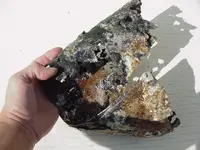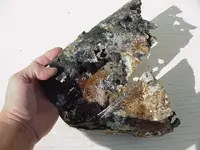Bigcypresshunter
Sapphire Member
- Joined
- Dec 15, 2004
- Messages
- 27,000
- Reaction score
- 3,340
- Golden Thread
- 0
- Location
- South Florida
- Detector(s) used
- 70's Whites TM Amphibian, HH Pulse, Ace 250
- Primary Interest:
- Beach & Shallow Water Hunting
I found this washed up on the beach of one of the 1715 wreck sites after hurricane Wilma. Looks like silver...is not magnetic... very corroded with coral and who knows what else growing on it. I will try electrolysis when our electric is restored. What could it be?





 could be zinc, tin or aluminum, they all looks sorta like that. How thick is it?
could be zinc, tin or aluminum, they all looks sorta like that. How thick is it? which means lead or tin.
which means lead or tin.
